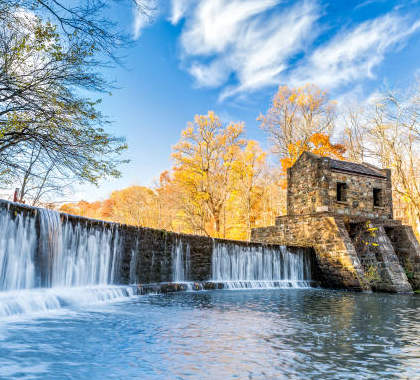Cities in New Jersey - Quick Facts, History & Geography
New Jersey Quick Facts
New Jersey's state nickname is the "Garden State" due to its rich agricultural history and lush farmlands. New Jersey became the 3rd state to join the United States on December 18, 1787. There are 52 cities in New Jersey as well as 324 incorporated places and 221 CDP's. New Jersey is the 47th largest state by land area and the 11th largest state by population. The capital city of New Jersey is Trenton, located in the central part of the state. Newark is the largest city in New Jersey, known for its cultural diversity, vibrant arts scene, and proximity to New York City. Newark has a population of 281,917 and is the 72nd largest city in the United States. The state is home to several prestigious universities and colleges, including Princeton University, Rutgers University and the New Jersey Institute of Technology. Salt water taffy was invented in Atlantic City, New Jersey back in 1883. New Jersey is the diner capital of the United States. There are more than 500 diners currently operating in the state. The very first full dinosaur skeleton was found in Haddonfield, New Jersey back in 1858. Newark is the 2nd most densely populated state with 1,215 people per square mile. In 1846, Hoboken hosted the very first baseball game. There are a total of 254 boroughs, cities, towns and villages in New Jersey. Famous people born in New Jersey include Bruce Springsteen, John Travolta, Jon Bon Jovi, Meryl Streep, Whitney Houston, Queen Latifah, Frank Sinatra, Martha Stewart, Bruce Willis, Ed Harris, Nathan Lane and Chelsea Handler.
Prior to European settlement, the Lenape Native American tribes lived in the region now known as New Jersey. The first European explorer to set foot in New Jersey was Henry Hudson in 1609, a Dutch navigator who explored the area for the Dutch East India Company. In 1664, the English gained control of New Netherland, renaming it New York and dividing it into two colonies: East Jersey and West Jersey. The territory was eventually combined into a single royal colony known as New Jersey in 1702. New Jersey played a pivotal role in the American Revolution. In December 1776, General George Washington led a daring and successful surprise attack on Hessian soldiers stationed in Trenton, a critical victory for the American forces. In the 19th century, New Jersey experienced industrialization, particularly in industries such as textiles, ironworking and transportation. Cities like Newark and Paterson thrived as manufacturing centers. Like many states in the northern region of the United States, New Jersey had a history of slavery. However, it gradually became a stronghold of abolitionist sentiment and played a role in the Underground Railroad, assisting enslaved individuals in their quest for freedom. New Jersey's industries continued to flourish in the 20th century, with significant contributions to the pharmaceutical, telecommunications, and technology sectors.
The Geography of New Jersey
New Jersey's geography is quite diverse and ranges from beautiful coastal areas along the Atlantic Ocean to rolling hills, farmlands and densely populated major cities. New Jersey is bordered by Delaware, Pennsylvania and New York. New Jersey has a scenic coastline along the Atlantic Ocean, stretching approximately 130 miles. The western border of New Jersey is defined by the Delaware River, which separates the state from Pennsylvania. In addition to the Atlantic Ocean, New Jersey's coastline includes Raritan Bay to the north and Delaware Bay to the south. Northern New Jersey is characterized by the Kittatinny Mountains and the Appalachian Highlands, part of the larger Appalachian Mountain Range. The Piedmont region, lying between the highlands and coastal plain, includes rolling hills, fertile valleys, and urban centers. The central part of the state is part of the Delaware River Basin, an area with numerous rivers and streams that contribute to the Delaware River's flow. New Jersey is heavily urbanized, with several major cities, including Newark, Jersey City and Trenton. Despite its urbanization, New Jersey has a strong agricultural presence, especially in the southern part of the state. Farms produce a variety of crops, including blueberries, cranberries, tomatoes, and corn.
New Jersey Relocation Guide
When people think of New Jersey they think of pizza, the Sopranos, Bruce Springsteen and maybe even Jersey Shore. What many don't see is what a great place New Jersey is to live. If you look at a map of New Jersey cities, you'd see that northern New Jersey is mountainous with ski resorts and small towns and plenty of employment opportunities. The east coast of New Jersey is a tourist haven with beautiful beaches and a massive tourism industry. Most cities in New Jersey are home to a diverse population and a broad range of cultures. Sporting some of the best cuisine in the nation; you can find Italian, Hispanic and Chinese restaurants all over the state.
Some cities in New Jersey struggle with crime, but the closely located suburbs offer some of the safest communities in the nation. The crime rate in New Jersey is almost half of the national average. The public school system in New Jersey is considered to be one of the best in America. The climate is mild with warm summers and cool to cold winters that can see a moderate amount of snowfall. Public transportation is extensive and allows travel between virtually any town in New Jersey as well as New York City, where a large population of the community commutes to. There are many jobs to go around with New Jersey's large urban area and major industries.
A great town to consider for relocation is Morristown. Located approximately 25 minutes west of Newark, this small town has plenty of action yet maintains a quiet and safe presence and has a very good Livability Score. There are many small restaurants and pubs throughout the town and make a great place for young college graduates or families.

